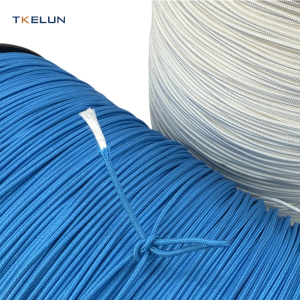Introduction
In the realm of high-performance materials, aramid fibers (e.g., Kevlar®) and Ultra-High Molecular Weight Polyethylene (UHMWPE) stand out for their exceptional strength, durability, and versatility. As a global supplier specializing in aramid and UHMWPE webbings and ropes, we aim to highlight their unique properties, applications, and advantages for industries ranging from marine engineering to robotics.
1. Key Differences Between Aramid and UHMWPE
Understanding the distinct characteristics of these materials is crucial for selecting the right product:
- Density & Buoyancy:
UHMWPE has a density of 0.97 g/cm³, allowing it to float on water, making it ideal for marine applications like mooring ropes. Aramid fibers, with a density of 1.4 g/cm³, sink but excel in high-temperature environments. - Thermal Resistance:
Aramid withstands temperatures up to 450°C, perfect for firefighting and aerospace. UHMWPE, however, melts at 145°C, limiting its use in high-heat scenarios. - UV Resistance:
UHMWPE demonstrates excellent UV stability, retaining strength even after prolonged sun exposure, while aramid degrades faster under UV light. - Chemical and Abrasion Resistance:
Both materials resist chemicals, but UHMWPE offers superior abrasion resistance, ideal for heavy-duty industrial ropes.
2. Applications Across Industries
These fibers are revolutionizing multiple sectors:
- Marine & Offshore:
UHMWPE ropes are lightweight, corrosion-resistant, and stronger than steel cables by weight, widely used in ship mooring and deep-sea operations. - Safety & Protective Gear:
Aramid’s heat resistance makes it a staple in fire-resistant gloves and ballistic armor. UHMWPE, with its high cut resistance, is favored for protective gloves and anti-ballistic fabrics. - Robotics & Advanced Manufacturing:
UHMWPE’s low density and high strength make it a leading choice for tendon-driven robotic hands, replacing traditional steel wires to reduce energy consumption. - Military & Aerospace:
Both materials are critical for lightweight armor, parachutes, and aircraft components. UHMWPE’s cold-weather performance (-150°C) outperforms aramid in extreme conditions.
3. Hybrid Solutions: Combining Strengths
Innovative blends of aramid and UHMWPE (e.g., aramid/UHMWPE hybrid yarns) address limitations:
- Enhanced Durability: Conductive fibers and anti-static treatments improve processability and reduce wear.
- Balanced Performance: Hybrid composites offer superior impact absorption and flexibility for applications like flexible armor panels.
4. Why Choose Our Products?
- Quality Assurance: Our UHMWPE ropes meet international standards, with strength 8x higher than steel cables by weight.
- Customization: Tailored solutions for specific needs, including UV-resistant coatings or hybrid designs.
- Global Supply Chain: Backed by China’s leading production capacity (over 60% of global UHMWPE output), ensuring competitive pricing and reliable delivery.
Conclusion
Aramid and UHMWPE are transforming industries with their unmatched properties. Whether you need heat-resistant aramid ropes for firefighting or lightweight UHMWPE straps for robotics, our solutions are engineered to exceed expectations. Contact us today to discuss how we can meet your high-performance fiber needs!
Keywords: Aramid ropes, UHMWPE webbing, high-strength fibers, marine ropes, robotic tendon materials, ballistic protection.
This blog leverages technical insights and market trends to position your products as cutting-edge solutions. For more details on specifications or custom orders, visit our website or reach out directly!
Contact:
Wechat:+86 18002912936
tksales002@tkelun.com

